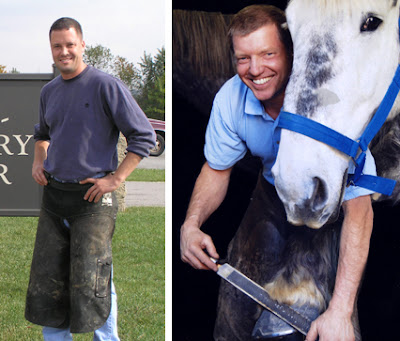The World Equestrian Games—formally known as the
2010 Alltech FEI World Equestrian Games™--is coming to the Kentucky Horse Park and if you think 2010 is a long way off, you’re just not thinking “big” enough.
The
American Farrier’s Association has been thinking big, though, and the news is that members of the AFA’s Executive Committee have met with Kate Jackson, Competition Director for the Games. At stake: cooperation between the Games and the AFA, who have agreed, in principle, to provide standby farrier services throughout the Games.
“I am pleased to inform you that I am presently in negotiations with the WEG on behalf of the AFA to determine an official level of recognition by the WEG of the AFA for services rendered by AFA Farriers to the WEG in 2010,” said AFA President-Elect Andrew Elsbree, who will take office on March 1st. “We are currently negotiating sponsorship levels with Kate Jackson,” he continued.
“AFA Farriers are the most qualified and best educated hoof care professionals to serve the multiple disciplines competing at this global equestrian event,” Elsbree said on Saturday. “We will be available before and during the Games to help competitors anyway we can!”
At Elsbree’s side in presenting the AFA’s offer to WEG was the AFA’s vice president, Dick Fanguy, who will, according to the AFA’s ascendancy scheme, probably be AFA president during the Games in 2010.
The AFA would probably have announced the agreement at their convention next month, but news of the relationship was leaked in an
article in a Lexington newspaper on January 18 by members of the FEI Games Foundation. The statement in the newspaper—that AFA members would shoe horses for free for WEG competitors—was incorrect, so a
correction appeared in a later paper, which drew more attention to the AFA’s relationship to WEG.
Wording of the title and how the AFA can make use of sponsorship is governed by official FEI Games policies and will be decided during further discussions between the AFA and Jackson, according to Elsbree.
“She’s had positive experiences with AFA certified farriers before,” Elsbree said, “And was delighted to think that we could manage the logistics for them.”
Rood and Riddle Equine Hospital stepped forward as a sponsor in return for being named the “Official Equine Hospital and Veterinary Partner” of the Games. Rolex watches are the “Official Timepiece” of the Games.
As Competition Director, Jackson will organize all logistical arrangements for the importation, quarantine, stabling, veterinary and training facilities for more than 900 horses from more than 60 nations as well as oversee and coordinate the production of the competitions.
By way of comparison, only 300 horses traveled to Los Angeles in 1984.
The AFA’s national headquarters is located in the cluster of offices on the grounds of the Kentucky Horse Park, where the Games will be held. The Park also features a small horseshoeing shop where visitors can watch a farrier work. Elsbree said he recently met with Horse Park Director John Nicholson about ways to improve the AFA’s visibility at the Horse Park.
At the 1984 Olympics in Los Angeles, farrier Ada Gates coordinated horseshoeing services, utilizing members of the Western States Farriers Association and local farriers. For that event, horses were stabled at the Santa Anita racetrack, where a farrier shop was made available to visiting farriers who were on site to serve clients or as official “team” farriers. Santa Anita provided a standby farrier all day for two weeks before the Games and during the Games. Those farriers made their trucks available to the visiting farriers. On competition days, standby farriers were on hand at competition sites and at the stables. Ada’s detailed article in the November/December 1984
American Farriers Journal is a chronicle of those weeks.
Pat Harmon, the late Bill Crowder and other farriers from Georgia worked together to provide farrier services during the 1996 Atlanta Olympics.
About the Games: The Alltech FEI World Equestrian Games will be held September 25-October 10, 2010, at the Kentucky Horse Park in Lexington, Kentucky. The event, which is held every four years, will decide the world champions of the eight equestrian disciplines recognized by the Fédération Equestre Internationale (FEI). The Games have never before been held outside of Europe; nor have all eight disciplines ever previously been held together at a single site. It is anticipated that more than 600,000 spectators will attend the 16-day competition.
Congratulations to the AFA for establishing a relationship with WEG. Watch for an official announcement of the agreement soon.
All HoofBlog text and images © Hoofcare Publishing 2008 unless otherwise noted.
To learn more about new research, products, and treatments for the horse's hooves and legs as reported to veterinarians and farriers in the award-winning "Hoofcare & Lameness Journal", go to http://www.hoofcare.com
Direct “subscribe now” link to Hoofcare & Lameness Journal: http://www.hoofcare.com/subscribe.html
Contact Hoofcare Publishing anytime:
tel 978 281 3222 fax 978 283 8775 email bloginquiry@hoofcare.com










